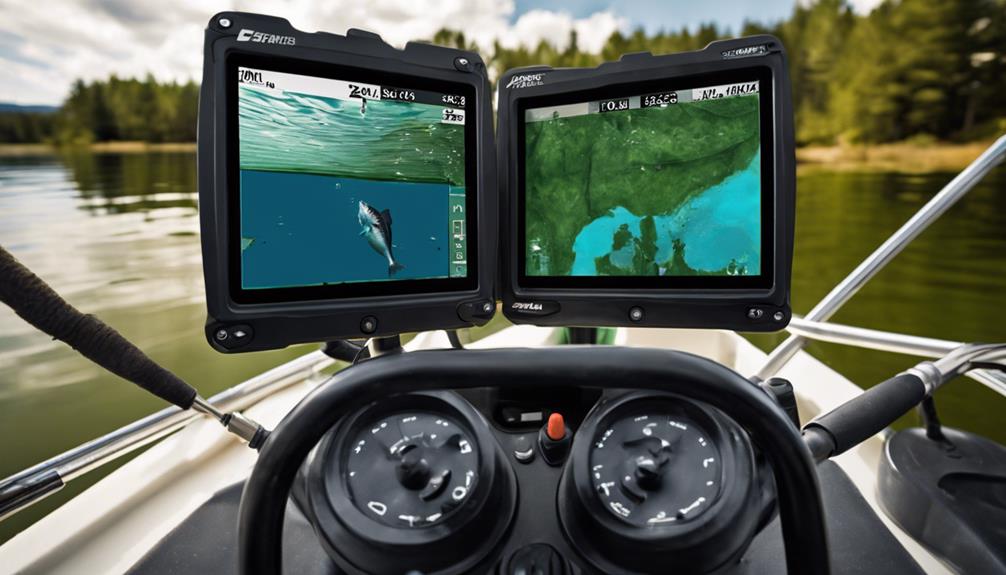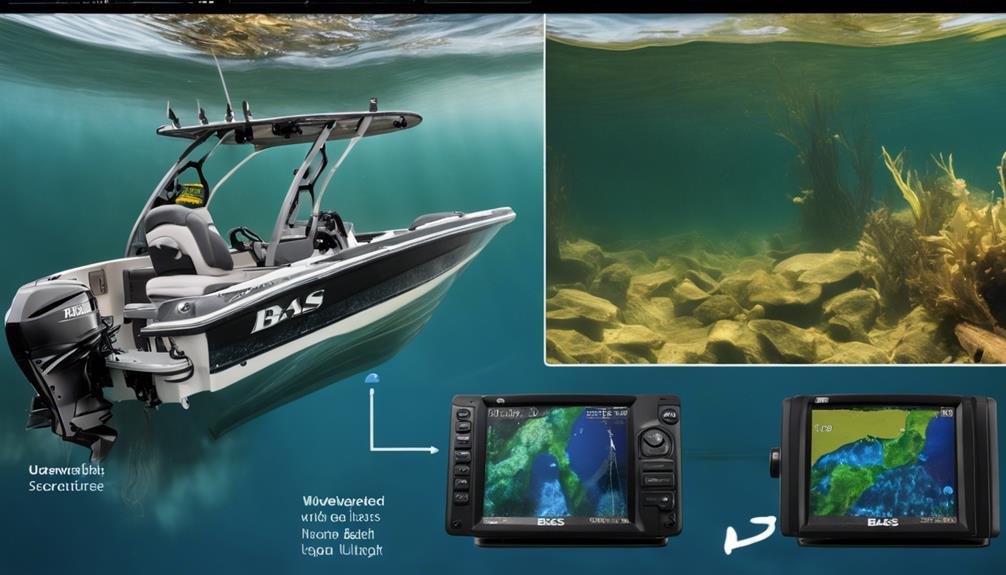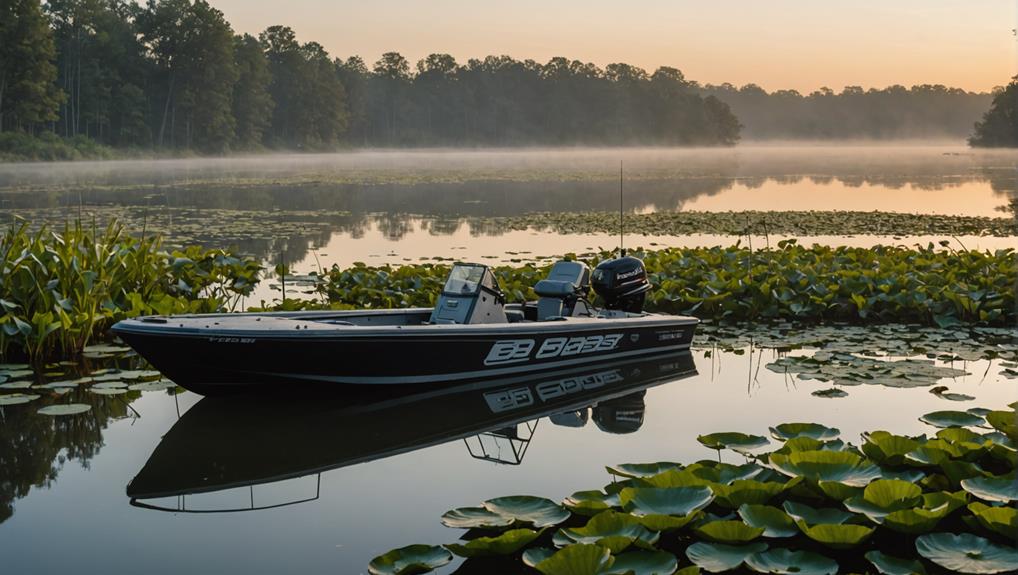You're looking for the best side imaging fish finders for bass, and it all starts with high-frequency CHIRP sonar and MEGA Side Imaging technology. Units like Humminbird's Solix 10 CHIRP MEGA SI+ G3 Fish Finder and Garmin's Side Imaging technology lead the pack, offering crisp, detailed displays and exceptional imaging capabilities. Key features to weigh include high-resolution displays, multiple imaging modes, and GPS map integration. To get the most out of your unit, a crucial aspect is to assess its capabilities, compatibility, and sensitivity settings. Explore the features and functions of top models to find the perfect side imaging fish finder for your bass fishing needs.
Key Takeaways
- Consider top-rated brands like Humminbird, Garmin, and Simrad for high-quality side imaging fish finders.
- Look for high-resolution displays with screen sizes ranging from 7-12 inches for clear and detailed images.
- Ensure the fish finder has multiple imaging capabilities, including side imaging, down imaging, and traditional sonar.
- Check for compatibility with trolling motors and GPS integration for seamless navigation and location marking.
- Evaluate the fish finder's image resolution, scanning range, and interference rejection to ensure optimal performance.
Top Picks for Bass Fishing
For serious bass fishing enthusiasts, selecting the right side imaging fish finder can be a game-changer. Humminbird's Solix 10 CHIRP MEGA SI+ G3 Fish Finder is a top choice, featuring 3 frequency settings (455 kHz, 800 kHz, 1070 kHz) and transom or trolling motor transducer compatibility.
This unit displays accurate readings on a 10" High Resolution Screen, even at operating speeds up to 60 knots.
When it comes to side imaging, Humminbird's MEGA side imaging technology provides unparalleled clarity. Garmin's Side Imaging technology is also a strong contender, offering detailed images of underwater structures.
For bass fishing, having a fish finder that can accurately detect and display the location of schools and individual fish is crucial. The HELIX series from Humminbird is another popular choice, offering CHIRP MEGA SI GPS capabilities.
When choosing a side imaging fish finder, consider the frequency settings, display resolution, and operating speed. These factors will substantially impact your ability to detect and catch bass. By selecting the right side imaging fish finder, you'll be able to locate and target bass with precision, giving you a competitive edge on the water.
How Side Imaging Fish Finders Work
A side imaging fish finder works by utilizing a specialized transducer that scans the area to either side of the boat, producing detailed images of underwater structures and fish.
As you operate your boat, the transducer sends sound waves into the water, bouncing off objects and returning to the transducer, which then interprets the signals to create an image on the screen.
With side imaging technology, you can view underwater structures and fish on either side of your boat, well over a hundred feet away. This is especially useful for bass fishing, as you can identify potential hiding spots and avoid spooking the fish.
Companies like Humminbird offer side imaging fish finders with high-quality transducers that can display crisp, clear images, such as the MEGA Down Imaging Transducer.
The use of GPS and mapping capabilities can also be integrated with side imaging, helping you pinpoint specific locations and navigate channels and flats with ease.
Key Features to Consider

When choosing a side imaging fish finder, you'll want to contemplate several key features that impact its performance and effectiveness. A larger screen with high resolution is essential, as it provides a clearer view of the underwater environment.
Ponder units with screens similar to the Humminbird Helix 7 Chirp or Garmin Echomap UHD, which offer crisp and detailed displays. Additionally, think about the imaging capabilities, such as down imaging and traditional sonar, which can enhance your fishing experience.
Trolling motor compatibility and interface control are also vital features to ponder. A user-friendly interface, like the one found on the Lowrance Elite FS, can make a significant difference in your fishing trip.
Moreover, a good GPS map will help navigate channels and flats, and some units come with pre-loaded maps or the option to purchase additional mapping cards. Units like the MEGA SI GPS G or HELIX 7 CHIRP MEGA offer advanced GPS capabilities, making them top contenders for the best side imaging fish finders.
When evaluating these features, you'll be well on your way to selecting a top-performing side imaging fish finder that meets your needs.
Side Imaging Fish Finder Buying Guide
Selecting the right side imaging fish finder can be an intimidating task, especially with the numerous options available on the market.
When contemplating a side imaging fish finder, you'll want to think about the screen size, which can range from 7-12 inches. For larger boats, a 10-12 inch screen is preferred, as it allows for easier visibility and better display of side imaging data.
A quality side imaging fish finder should also have a clear and high-resolution display, with features such as Mega Imaging, which can expand the range to 250 feet off either side of the boat, and CHIRP sonar capabilities for high-quality images and fish mark separation.
You'll also want to evaluate the interface control, with options including touch screen, keypad, or joystick control. Some units, like Humminbird fish finders, offer a combination of these for ease of use.
Additionally, think about the durability and waterproofing of the unit, as it will be exposed to the elements and rough water. Look for units with rugged construction and IP67 or higher waterproof rating.
Trolling motor compatibility is also important, as some side imaging fish finders are designed to work with specific brands and models of trolling motors.
Testing and Evaluation Process

To evaluate the best side imaging fish finders, you'll want to understand the testing methods used to assess their performance.
You'll apply specific evaluation criteria to determine how well each unit meets your needs, including factors like image resolution, scanning range, and interference rejection.
Testing Methods Used
Our testing process for side imaging fish finders was designed to push each unit to its limits, simulating the various conditions you'll encounter on the water.
We evaluated each unit's screen size, modes, mounting options, touch screen functionality, and NMEA capability to gauge their performance in different settings. Whether you're bass fishing in a lake or saltwater, our testing methods were designed to provide an unbiased review of each unit's features, user interface, and overall performance.
We tested each unit's compatibility with trolling motors, GPS, and other fishing-related features to guarantee smooth integration. We also considered the user experience, evaluating how easy it's to navigate the menu, adjust settings, and interpret the data on the screen.
For example, we compared the screen size and resolution of the Humminbird unit to others in its class, evaluating how well it displays side imaging data. By using a thorough testing process, we were able to identify the top-performing side imaging fish finders for bass fishing and provide recommendations for anglers.
Our testing methods were designed to give you the information you need to make an informed decision when choosing a side imaging fish finder for your next fishing trip.
Evaluation Criteria Applied
When evaluating side imaging fish finders, five key criteria stood out as pivotal in determining their performance and effectiveness. As you navigate the world of side imaging technology, it's imperative to take these factors into account to make an informed decision.
First, the quality of the side imaging itself is paramount. Look for units that provide clear, high-resolution images of the underwater environment, even in shallow water. Humminbird fish finders, known for their exceptional side imaging capabilities, set the standard for this criterion.
Next, take into account the unit's ability to provide accurate depth readings and bottom contour mapping. This information is indispensable for identifying potential fishing hotspots.
The use of this site's resources can help you better understand how to interpret this data. Additionally, the effectiveness of the unit's forward-facing sonar is critical, as it can make a huge difference in detecting fish and structure.
Key Performance Metrics
Evaluating side imaging fish finders requires a rigorous testing and evaluation process to determine their key performance metrics. When you're in the market for a side imaging fish finder, you need to ponder several factors that impact its performance.
You'll want to assess the unit's ability to produce clear, detailed images of the water column and surrounding structure.
Key performance metrics to evaluate include resolution, imaging range, and scanning speed. A high-resolution side imaging fish finder, such as the Humminbird Solix, will provide a more detailed view of the underwater environment.
You'll also want to ponder the imaging range, which affects how far to the side you can scan. The Best Overall side imaging fish finder will offer a wide imaging range, allowing you to scan large areas of the water column. Additionally, look for a unit with fast scanning speeds, such as those with Active Imaging or Live Scope technology, which provide real-time imaging.
When outfitting your Bass Boat with a side imaging fish finder, ponder these key performance metrics to guarantee you get the best results.
Choosing the Right Side Imaging Unit
When selecting a side imaging unit, you'll need to ponder the brand and its reputation for producing high-quality products.
Setting up your unit correctly is also vital to guarantee you get accurate and reliable readings. By choosing a reputable brand and following the manufacturer's setup instructions, you'll be able to get the most out of your side imaging unit and start finding fish more effectively.
Choosing a Brand
As you ponder investing in a side imaging fish finder, selecting the right brand is crucial to guarantee you get a unit that meets your fishing needs.
You'll want to ponder brands that offer high-quality side imaging capabilities, such as Humminbird, Garmin, and Simrad. Humminbird's Solix series, for example, is widely used by fishing guides and professionals for its exceptional side imaging for fish finding and structure identification.
Garmin's 943xsv offers UHD side scan capabilities, while Simrad's sidescan technology effectively shows fish and bait schools, as well as structure and bottom composition.
When evaluating these brands, ponder the specific features that matter most to you.
If you're targeting bass, look for units with advanced side imaging capabilities that can help you identify structure and fish habitats.
Also, ponder the type of fishing you'll be doing most often – freshwater, saltwater, or both.
By choosing a brand that aligns with your fishing needs, you'll be able to get the most out of your side imaging fish finder and improve your chances of landing more bass.
Setting It Up
With your brand selected, it's time to focus on choosing the right side imaging unit that meets your specific fishing needs. When selecting a side imaging unit, consider the following key factors:
- Screen size: A 10-12 inch screen is ideal for larger boats, while 7-9 inches is suitable for smaller boats or kayaks.
- Transducer type and frequency: CHIRP sonar offers high-quality images and fish mark separation, while the GT56 transducer provides clear side imaging.
- Unit compatibility: Guarantee the unit is compatible with your trolling motor and GPS maps, with Navionics-based maps preferred for their wide range of water bodies and user updates.
- Additional features: Consider units with advanced features like Humminbird's Solix, which offers a larger screen size and more advanced features, making it easy to locate fish on either side of your boat.
Humminbird fish finders are a popular choice for side imaging, with the Solix offering the biggest screen and most advanced features.
Garmin Echomap and Simrad GO series are also viable options, offering ultra-high-definition imaging and Active Imaging 3-in-1 sonar. Choose a unit that's easy to use and meets your specific fishing needs.
Expert Tips for Using Side Imaging

[TEXT]:
To get the most out of your side imaging fish finder, it's vital to understand how to interpret the data it provides.
When using side imaging, you'll want to focus on identifying structure, such as drop-offs, weed beds, and submerged logs, which are attractive to bass.
Look for irregularities in the image, like dark spots or changes in color, which can indicate the presence of fish.
When scanning for Striped Bass, for example, use a combination of side imaging and traditional 2D sonar to pinpoint their location.
Garmin and Humminbird fish finders offer advanced side imaging capabilities, including the ability to adjust sensitivity and contrast to optimize image quality.
To refine your technique, experiment with different transducer angles and speeds to achieve the best image. Additionally, pay attention to the time of day and water conditions, as these can affect the accuracy of your side imaging readings. By mastering these expert tips, you'll be able to effectively use your side imaging fish finder to locate bass and increase your catch rate.
Frequently Asked Questions
Which Fish Finder Has the Best Side-Imaging?
You'll want a fish finder with advanced side imaging technology, high-quality imaging sensors, and excellent image resolution. Compare side scan ranges, imaging frequency options, and transducer design. Also, consider imaging software features for peak performance.
What Is the Best Fishfinder for Bass Fishing?
While considering bass behavior patterns, you'll want a fish finder that accurately interprets water temperature effects on their habitats. Look to top brands like Humminbird or Garmin, and guarantee proper installation for effective lake structure analysis and bass habitat identification.
What Do Bass Beds Look Like on Side-Imaging?
You'll recognize bass beds on side-imaging as defined, darker or lighter areas, typically 1-4 feet in diameter, often accompanied by structures like sunken logs, rocky outcrops, or submerged weed beds, which indicate prime spawning grounds.
What Fish Look Like on Side-Imaging?
You'll see fish as arches or inverted "V" shapes on side-imaging, with size and shape indicating species and depth. Image clarity, sonar sensitivity, and water conditions affect identification, while structure detection and species differentiation require careful image interpretation.
Conclusion
You'll be hooked on side imaging fish finders for bass fishing after reading this! These game-changing devices will transform your fishing trips into treasure hunts, revealing hidden structures and schools of bass like never before. With the right unit, you'll be reeling in monsters in no time. Don't settle for mediocre fishing trips – invest in a high-quality side imaging fish finder and get ready to experience the most epic bass fishing adventures of your life!

My love for fishing began when I was just a kid, spending summers on the lake with my grandfather. As I grew older, my passion for the sport only intensified, and I began to explore the latest advancements in fishing technology. I quickly realized that there was a lack of reliable and trustworthy resources available for anglers, and I saw an opportunity to fill that gap.

